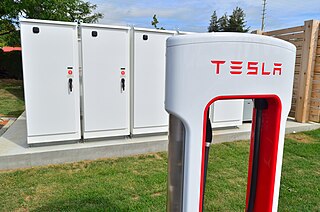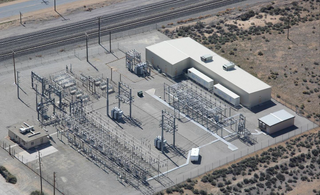
Compressed-air-energy storage (CAES) is a way to store energy for later use using compressed air. At a utility scale, energy generated during periods of low demand can be released during peak load periods.

The Moss Landing Power Plant is a natural gas powered electricity generation plant located in Moss Landing, California, United States, at the midpoint of Monterey Bay. Its large stacks are landmarks, visible throughout the Monterey Bay Area. The plant is owned and operated by Houston-based Dynegy and currently has a generation capacity of 1020 MW (net) from its two combined cycle generation units. It was once the largest power plant in the state of California, with a generation capacity of 2560 MW, before its two large supercritical steam units were retired in 2016.

The AES Corporation is an American utility and power generation company. It owns and operates power plants, which it uses to generate and sell electricity to end users and intermediaries like utilities and industrial facilities. AES, headquartered in Arlington, Virginia, is one of the world's leading power companies, generating and distributing electric power in 15 countries and employing 10,500 people worldwide. AES Corporation is a global Fortune 500 power company. AES Ranks in the Top Ten of Fast Company's 2022 Best Workplaces for Innovators.

Wind power in Texas, a portion of total energy in Texas, consists of over 150 wind farms, which together have a total nameplate capacity of over 30,000 MW. If Texas were a country, it would rank fifth in the world; the installed wind capacity in Texas exceeds installed wind capacity in all countries but China, the United States, Germany and India. Texas produces the most wind power of any U.S. state. According to the Electric Reliability Council of Texas (ERCOT), wind power accounted for at least 15.7% of the electricity generated in Texas during 2017, as wind was 17.4% of electricity generated in ERCOT, which manages 90% of Texas's power. ERCOT set a new wind output record of nearly 19.7 GW at 7:19 pm Central Standard Time on Monday, January 21, 2019.

Roosecote Power Station was a gas-fired, originally coal-fired power station, situated in the Roosecote district of Barrow-in-Furness in Cumbria, North West England. The gas-fired station opened in 1991 and was the first CCGT power station to supply electricity to the United Kingdom's National Grid, but was mothballed in 2012 after a proposed biomass power station was cancelled. It was situated directly adjacent to Rampside Gas Terminal. The plant was demolished between 2014 and 2015. The site is now a 49 MW battery storage facility.

The energy sector in Hawaii has rapidly adopted solar power due to the high costs of electricity, and good solar resources, and has one of the highest per capita rates of solar power in the United States. Hawaii's imported energy costs, mostly for imported petroleum and coal, are three to four times higher than the mainland, so Hawaii has motivation to become one of the highest users of solar energy. Hawaii was the first state in the United States to reach grid parity for photovoltaics. Its tropical location provides abundant ambient energy.
Canadian Solar Inc. is a global renewable energy company. Headquartered in Guelph, Ontario, the company manufactures solar PV modules, provides battery energy storage solutions and develops utility-scale solar power and battery energy storage projects.
BYDEnergy Storage System is independently developed by the Chinese company BYD who begun with its battery manufacture business but later expands to diverse fields like new energy, EV etc., including energy type and power type. The energy type system can discharge for a long time, while the power type can supply big power for a short time. BYD Energy Storage System can realize, as the company announced, the function as below:frequency regulation, substation grid support, distributed energy storage system (DESS), PV/Wind integration, commercial energy management etc.
Cryogenic energy storage (CES) is the use of low temperature (cryogenic) liquids such as liquid air or liquid nitrogen to store energy. The technology is primarily used for the large-scale storage of electricity. Following grid-scale demonstrator plants, a 250 MWh commercial plant is now under construction in the UK, and a 400 MWh store is planned in the USA.

The Tesla Powerpack was a rechargeable lithium-ion battery stationary energy storage product, intended for use by businesses or on smaller projects from power utilities. The device was manufactured by Tesla Energy, the clean energy subsidiary of Tesla, Inc. The Powerpack stores electricity for time of use load shifting, backup power, demand response, microgrids, renewable energy integration, frequency regulation, and voltage control. The first prototype Powerpacks were installed in 2012 at the locations of a few industrial customers. After July 22, 2022, the product was no longer listed for sale.

A battery energy storage system (BESS), battery storage power station, battery energy grid storage (BEGS) or battery grid storage is a type of energy storage technology that uses a group of batteries in the grid to store electrical energy. Battery storage is the fastest responding dispatchable source of power on electric grids, and it is used to stabilise those grids, as battery storage can transition from standby to full power in under a second to deal with grid contingencies.
The Hornsdale Wind Farm is an electricity generator in the locality of Hornsdale in the south-west of the Narien Range, north of Jamestown, South Australia. It consists of 99 wind turbines with a generation capacity of 315 megawatts (422,000 hp). The plant is owned and operated by Neoen, a French renewable energy company.

A gravity battery is a type of energy storage device that stores gravitational energy—the potential energy E given to an object with a mass m when it is raised against the force of gravity of Earth (g, 9.8 m/s²) into a height difference h.
Hornsdale Power Reserve is a 150 MW grid-connected energy storage system owned by Neoen co-located with the Hornsdale Wind Farm in the Mid North region of South Australia, also owned by Neoen.

The Tesla Megapack is a large-scale rechargeable lithium-ion battery stationary energy storage product, intended for use at battery storage power stations, manufactured by Tesla Energy, the energy subsidiary of Tesla, Inc.

The Tehachapi Energy Storage Project (TSP) was a 8MW/32MWh lithium-ion battery-based grid energy storage system at the Monolith Substation of Southern California Edison (SCE) in Tehachapi, California, sufficient to power between 1,600 and 2,400 homes for four hours. At the time of commissioning in 2014, it was the largest lithium-ion battery system operating in North America and one of the largest in the world. TSP is considered to be a modern-day energy storage pioneer with significant accomplishments that have proven the viability of utility-scale energy storage using lithium-ion technology. While originally envisioned as a research and development project, TSP operated as a distribution-level resource for SCE and for calendar year 2020, SCE reported that TSP operated in the wholesale energy market with revenue exceeding operating and maintenance costs. In 2021, SCE began the decommissioning of TSP, which was followed by formal decommissioning by state regulators in 2022. The physical dismantlement of TSP is expected to be completed by the end of 2022.
Gateway Energy Storage is a large-scale battery storage power station, operated by grid infrastructure developer LS Power. It has 250 MW of power and a storage capacity of 250 MWh, using lithium-ion battery cells from LG Chem.
The Fekola Hybrid Power Station is a 115 MW (154,000 hp) power plant in Mali. The power system comprises 68 MW of thermal energy, 30 MW of solar power and 17.3 MW of lithium ion battery energy storage. The power station is owned by B2Gold Corporation, a Canadian mining company. Dornier Suntrace GmbH and BayWa, two German engineering consulting and construction companies were hired to advise, design, build, operate and maintain this power station. The off-taker is the Fekola Gold Mine, in southwestern Mali, that is off-grid and is owned by B2Gold.

Enel North America is an American company headquartered in Andover, MA, United States. One of the renewable energy operators in North America, it was formed as a subsidiary of the global utility Enel S.p.A. in 2000. It has operations in the United States and Canada through its renewables and energy services businesses, with a portfolio including over 9.6 GW of renewable capacity, 160,000 EV charging stations, 4.7 GW of demand response capacity and 14 utility-scale battery energy storage systems, totaling 1,416 MWh of capacity under construction or in operation. It serves a customer base of over 4,500 businesses, utilities, and cities in North America.
Compressed carbon dioxide energy storage can be used to store electrical energy at grid scale. The gas is well suited to this role because, unlike most gases, it liquifies under pressure at ambient temperatures, so occupies a small volume. Energy Storage News reported that it will be "a cheaper form of energy storage than lithium-ion batteries".










